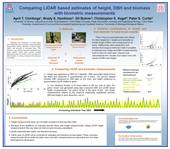Highlight
Comparing two approaches for estimating forest biomass: biometric measurements and ground-based LIDAR measurements
Achievement/Results
Standing stock biomass of forest stands have traditionally been estimated using allometric relationships relating diameter at breast height (DBH) and/or stem dissections to tree height or biomass. This method is less suited to estimating biomass over larger spatial scales than remote sensing approaches such as LiDAR, which can allow for determination of canopy structure and individual tree height. However, the accuracy of estimates made via remote sensing had not been determined.
BART fellows (April Chiriboga and Brady Hardiman) and BART faculty (Gil Bohrer, Chris Vogel, and Peter Curtis) collaborated on research comparing estimates of forest biomass made using ground-based LiDAR measurements, measurements of DBH, and stem dissections. These researchers felled thirty aspens for stem dissection, and height and DBH were measured and biomass estimated for all trees. A comparison of biomass estimated via these biometric measurements with biomass estimates made using ground-based LIDAR measurements showed that t the LDAR technique significantly underestimates height/biomass in forests with dense understories.
This is an important finding as well as an example of the application of a tool frequently used by atmospheric scientists to an ecological question. These researchers are now considering how site-specific corrections based on canopy structure might be made to the LIDAR data to remove this bias and thereby provide a feasible approach for the determination of biomass at scales where biometric measurements are impractical and/or over large, heterogeneous landscapes.
Address Goals
Numerous studies of carbon dioxide fluxes are underway across the globe with the aim to better understand the exchange of carbon between the atmosphere and terrestrial ecosystems. Future predictions of climate and ecosystem response to climate change require the use of models in which highly parameterized treatments of atmospheric dynamics and forest processes and coupled so that quantitative estimates of carbon sequestration can be obtained. Biometric measurements are extremely labor intensive and thus not suitable when addressing questions relating to large scales and/or challenging terrain. While remote sensing techniques may represent suitable alternatives, their accuracy and thus utility has not yet been fully characterized. This research has shown that LiDAR measurements can significantly underestimate tree height and biomass in forests with dense understories. Further studies of canopy structure may yield site-specific correction factors that can be applied to remove this bias and provide a quantitative approach for the estimation of biomass over large scales and heterogeneous landscapes.






